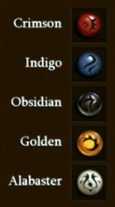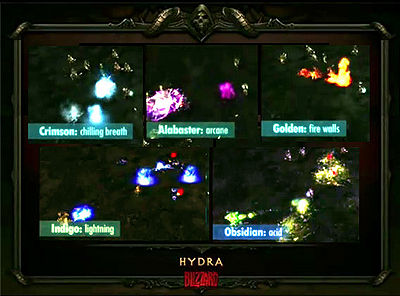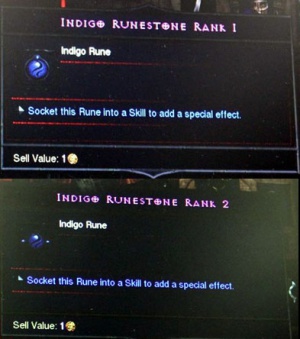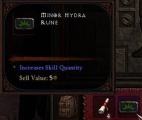Skill Runes
Runestones are small items that can be socketed - one each - into any skill, but not into traits or into items, as were runes in Diablo II. Diablo III's skill runes grant special bonuses to the skills with which they are used, altering their effects and generally enhancing them, although the changes that a rune makes to a skill may dramatically alter a its utility.
- See all news related to runestones in Diablo III.
- Rune Archive -- Runes evolved greatly during the development of Diablo III. See the archive page for a history lesson.
Rune Basics
Runestones come in five types, and a particular kind of bonus or alteration is typical of each. For instance, the Crimson Rune often adds damage. However the effects that runestones have vary greatly with the skills themselves - a skill that doesn't deal damage may not gain a damaging effect from a Crimson Rune, but rather be altered in some other way.
In addition to the five types, Runestones also occur in seven levels of quality, with increasingly potent effects. A Runestone of one level always has a more dramatic effect than a Runestone of a lower level, usually in the sense that it affects a given skill in the same way, but to a greater extent. It is not generally known whether or not it will be possible to combine Runestones of one quality level to generate higher-level Runestones, however all seven quality levels are dropped by monsters[1].
The Runestone naming scheme has changed several times during development. The current iteration was devised in early 2010 and made public in May of that year when Bashiok [2] revealed the names to be Crimson, Indigo, Obsidian, Golden and Alabaster. This change coincided with considerable changes to their effects.
D3 Runestones vs. D2 Runes
Diablo III's Runestones are nothing like the 'runes' found in Diablo II. In D2 there are thirty-three kinds of runes, which are small items that have no use on their own, but can be placed in item sockets to add various bonuses to those items, and in certain combinations produce RuneWords, which add powerful, predetermined sets of bonuses, provided that the item has precisely the right number of sockets.
Runestone Functions
Runes have no function on their own, other than beautifying your inventory. They are only useful once they're socketed into a skill, where they alter the skill's function and often improve it. However runic alterations may make a skill less suitable to a particular use. The Wizard's skill 'Ray of Frost,' for instance, produces a straight beam that deals damage and slows enemies instantly at any range when un-runed, but produces a swirling, 360-degree field of sleet in the Wizard's immediate vicinity when under the effect of an Indigo rune, or deals less damage but has a greater slowing effect when under the effect of an Obsidian rune.
The functions of the Runestones are not entirely predictable in a given skill. Their bonuses vary greatly, and each type has a unique effect on each skill. Devising and implementing the effects of the Runestones was a tremendous amount of work for Diablo III's developers and artists; there are nearly 120 skills in the game, each with a basic function and five Runestone permutations in seven levels of potency.
Prior to Blizzcon 2010, the Runestones (which had different names at the time) were generally accepted to do the following:
- Alabaster rune: Wild card functions.
- Crimson rune: Generally provides +damage and/or fire damage.
- Golden rune: Generally reduces the resource cost.
- Indigo rune: Generally provides multishot in some form.
- Obsidian rune: Wild card functions.
Higher-Level Runestone Functions
A Runestone's function tends to vary in a quantitative way with its level of quality, rather than in a qualitative way. For example, an Indigo Rune adds multishot to Magic Missile; higher level Indigo Runes don't change that function, but rather increase the number of projectiles generated. However Runestones of some quality levels also have qualitative advantages over lower-level Runestones of the same type.
Runestone Scarcity
There are seven Runestone quality levels, roughly distributed so that levels one through three are found as a character progresses through Normal, four and five are found in Nightmare, and six and seven are found in Hell (each Runestone's quality can be determined by the number of points around its edge). It's not known how common or rare Runestones will be, or whether or not all five types will be equally difficult to find. The most recent information about the subject came from a forum post by Bashiok in January 2011.[3]
- Question: Are all five runes equally as rare or is one or more types rarer than others?
- Bashiok: That’s a good question, I can see how that could be justified. I don’t know what the plan is there, I’ll have to ask. My gut is that it would be too much to keep some type of rune ‘power rating’ in mind when altering drop rates, especially post-release where patches could jumble them around a fair bit. “This rune sucks now but it’s still the rarest!” Also, ideally, each rune type will be equally viable to different people and builds. Saying one is more powerful than another would mean we’re probably balancing them to be, and that’s not the case.
Rune Crafting/Upgrading
The D3 Team has confirmed that the Mystic will have some crafting recipes to create new Runestones, though there are no details yet, other than that they will use old Runestones in the process. It will also be possible to salvage unneeded Runestones for magical materials, and even make new ones from scratch.
Rune Storage
In the Diablo III demo at BlizzCon 2008 runes were stored in a seperate inventory grid on the skill tree menu rather than in the normal inventory. They are now stored in the main inventory, and can be stacked to save space.
Easy Socketing

Socketed runestones will be freely swappable. Players will be able to replace runestones at any time, at no cost and without risk of losing the runestone. The D3 Team has committed to easy runestone swapping in the final game, but they have said there will be some sort of limitation, purely to prevent macro-switching exploits. They want swapping to be easy and forgiving, but not something that can be done automatically by a third party program, which could lead to constant, effortless switching, which they think of as contrary to their intended style of play. The team has not yet revealed what form this limitation will take, but it could be something as simple as requiring players to return to town.
Confirmed Runestone Examples
While one or two rune properties are known (or can be easily guessed) for most skills, we only know all five rune bonuses for a few skills; ones that Blizzard has revealed in panels or interviews.
Plague of Toads
The rune functions for Plague of Toads, a Witch Doctor skill were revealed during a panel discussion at Blizzcon 2010. The basic skill has the Witch Doctor throwing out several toads, which hop forwards in erratic, Charged Bolt-esque fashion.
- Alabaster rune: The toads also blind enemies.
- Crimson rune: Flaming toads add fire damage to their attack.
- Golden rune: Reduced cost per cast.
- Indigo rune: Changes the skill to a rain of toads, which fall down on the targeted location.
- Obsidian rune: Summons a single, huge, stationary frog that uses a sticky tongue to capture and consume monsters in one gulp. It spits out the treasure and items. The mega-toad can eat Champions (possibly only at higher/highest rune level?), but not bosses or (presumably) bigger enemies.
Poison Dart
The rune functions for Poison Dart, a Witch Doctor skill, were revealed during a panel discussion at Blizzcon 2010. The basic skill is a fairly slow-working spell that fires a single poison dart that deals poison damage and some DoT.
- Alabaster rune: Blows out a face-biting snake that stuns the target
- Crimson rune: Adds fire damage to the poison dart.
- Golden rune: Steals mana with each dart hit.
- Indigo rune: Fires multiple darts.
- Level One: Two darts.
- Level Two: Four darts.
- Obsidian rune: Slows the poisoned target.
Hydra
The rune functions for Hydra, a Wizard skill were revealed during a panel discussion at Blizzcon 2010. The basic skill summons a fiery dragon that breaks through the earth and spits firebolts at nearby enemies.
- Alabaster rune: Turns the Hydra purple and the damage type to Arcane.
- Crimson rune: Turns the Hydra blue and the damage type to a short-range chilling frost spray.
- Golden rune: Creates a giant hydra that deals higher damage via AoE Firewalls.
- Indigo rune: Turns the hydra blue and the projectiles to lightning balls that never miss.
- Obsidian rune: Turns the hydra green and the damage to a splashing poison acid.
This Hydra information was revealed at Blizzcon in October 2010. It shows changes even since August, when one of Hydra's rune effects was a faster/multishot, instead of the Acid element.
These bonuses also show how unpredictable the effects are. By previous knowledge and logic, Crimson should be the +damage/firewalls effect, since it generally adds damage and/or fire effects. Possibly the developers are shuffling rune bonuses around randomly, in order to make the runes equivalently useful. Rather than, for instance, allowing Crimson to be the most useful and Golden the least, on the whole.
Throw Weapon
The rune functions for Throw Weapon, a Barbarian skill, were revealed during a panel discussion at Blizzcon 2010. The basic skill is a ranged attack in which the Barbarian is able to hurl his weapon with distance and accuracy. The weapon magically reappears in his hands after each toss.
- Alabaster rune: Enemies struck by the weapon grow confused.
- Crimson rune: Adds damage to the thrown weapon.
- Golden rune: Throws a monster corpse rather than the weapon. Less range, but bigger damage.
- Indigo rune: Adds ricochet, allowing the weapon to strike multiple targets.
- Obsidian rune: Throws a stunning hammer, rather than the equipped weapon.
Runestones In Video
In May 2011 Blizzard released a set of five videos, one for each of the classes, demonstrating various runestones in a single skill each.
Barbarian's Whirlwind
Demon Hunter's Cluster Arrow
Monk's Sweeping Wind
Witch Doctor's Acid Cloud
Wizard's Ray of Frost
Rune Tool Tips
The tool tip that displays when a rune is hovered over is not informative. It simply says, "socket in skills for a special bonus." To obtain information about what a rune actually does, players need to click on the rune to pick it up, then hover it over their available skills. The tool tip will then briefly describe what effect the rune will grant that skill.
Since just the word descriptions aren't that informative, most players will want to test out runes, or else find additional information from a wiki or video of the skill in action.
Media
Various images of Runestones and Rune Effects.
References
- ↑ Bashiok forum post - Blue Tracker, January 2011
- ↑ Bashiok forum post - Blue Tracker, May 2010
- ↑ Bashiok forum post - Blue Tracker, January 12, 2011







